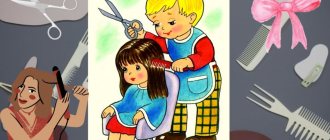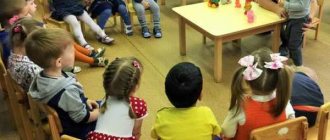Preview:
Municipal preschool educational institution "Kindergarten "Fairy Tale" in the village of Turgenevsky, Pugachevsky district, Saratov region"
Didactic games on formation
in preschool children
Goal: to develop the ability to behave correctly in society, to comply with cultural and hygienic standards; learn to assess the current situation, analyze the actions of others; develop the concept of cultural behavior.
Progress of the game. The teacher shows children plot illustrations depicting various situations. For example, the picture shows how a child throws toys, brushes teeth, helps an elderly person climb the stairs, etc. Children should determine and justify the answer about which situation is positive and which is negative.
Exercise game. “Every thing has its place.”
Target . Reinforce the rule “Every thing has its place.” Find out whether children know the location of toys and things necessary for independent activities.
Preliminary work. Together with the children, they tidied up toys and aids and placed them in places convenient for use.
Methodological techniques. Reading the poem “Masha the Confused”, questions for children:
- Children, why do you think the girl is called confused?
- What needs to be done so that she is not called confused? Masha couldn't find anything because she didn't know a good rule.
- Now let's see if you know the place of each thing.
- Alyoshenka, please bring me a book. Thank you. Olechka, be kind, give me the Tanya doll, please. Thank you. Alyonushka, do a good deed, put baby Andryushka in the stroller. Well done.
- Children, why didn’t you look for anything and quickly fulfilled my requests?
- We know where they are.
- Yes, children, every thing should have its place. There is also the rule “Where you got it, put it there.” It will help maintain order in the group.
Goal: To develop children's intelligence, sense of humor, and reinforce the rules of behavior in public places.
Progress of the game: The teacher begins the story in the place where he left off; the children say “And I... if these words fit the meaning.
I came to the store... There are a lot of goods there, I decided to buy myself a blouse, but didn’t pay.....
Exercise game. "We are sailing on a boat."
Target. Establish rules of behavior in transport.
Materials for the game: steamer screen, cash register, chairs, tickets, child dolls.
Progress of the game. Invite the children to sail on a boat. Children list the rules of behavior in transport. The teacher adds. The "Captain" takes his place at the helm. Children with tickets calmly take their seats. When all the seats are occupied, the teacher comes in with the Dunno doll. One of the children gives way to the teacher. The teacher thanks the child. Dunno starts talking loudly, tries to put his feet on the seat, and throws candy wrappers around. The teacher asks the children to remind Dunno how to behave in transport, what to do in different cases. Children willingly point out to Dunno his mistakes. Dunno thanks.
The game continues, but in a modified form. Having given the children independence, the teacher observes the relationships between the children and the actions of each one.
Mastering the rules is facilitated by games and exercises, when the teacher describes the situation in one phrase, and the children characterize it and answer how to behave. For example :
- If you start jumping on the bus, talking loudly, then... (children's answer).
- If you climb onto the seat with your legs, then...
— If a girl was walking, tripped over a stone and dropped her doll, then...
— If grandma gets on the bus, but there are no empty seats, then. etc.
"Good, bad deeds."
Objectives: To foster in children friendly relationships, a sense of self-esteem and respect for others, the ability and desire to come to the aid of adults and peers. Enrich children's moral understanding with positive examples from life.
- Many glorious deeds await us in life, but first of all we must grow into real people: what kind of people? (Kind, brave, sympathetic, well-mannered, smart, etc.)
- What other ones? (Polite.)
-A polite person is always attentive to people. But sometimes guys behave rudely not only with their peers and strangers. Rudeness and disrespect are a sign of poor upbringing.
-Look at this page for multi-colored cards with question marks on them. These cards cover pictures that depict children in different situations; you will need to tell where the children behave well and where they act poorly.
-Open the cards, the top will help us. The stick needs to be inserted into the wheel, which color appears on the top, and we will open the card with that color. (The teacher spins the top, opens the cards, and the children talk about what is shown in the pictures.)
Exercise game. “Let’s get dressed for a walk.”
The game takes place in the locker room.
Target. Foster the need to take care of clothing. To develop the skill of sequential dressing actions. Activate polite words: please, thank you, be kind.
Preliminary work. The children learned to use polite words.
Methodological techniques. Invite the child (who has mastered the sequence of actions) to dress properly and ask for help. Ask the children if Olya did everything right, what polite words she used. Say: “Now you get dressed, and Olya and I will see how great you are.”
Objectives: To form the social and emotional sphere of the child - the ability to identify and distinguish between human emotions and feelings. Develop imagination
Animals have feelings
In fish, flowers and people
No doubt it influences
We're all in the mood!
-It happens to all of us that we are having fun, or on the contrary, we are sad or angry, this is called mood or emotions. What do you think causes our mood to change?
-The mood changes depending on the situations in which you and I may find ourselves. For example, you were praised and you were in a good mood, but if suddenly you did something bad and you were punished for it, then your mood will most likely deteriorate.
-Look, on this page there are little people who have turned their backs to us, they all have different moods. To find out which one, one of you will carefully take out the little man, look at it without showing it to anyone, and try to portray the emotion that the little man expresses, and you and I guys will have to guess it. (The child takes out a little man, depicts an emotion, the rest of the children guess.)
Educator: We have discovered all the little people with you, let’s now depict these emotions all together.
Children depict: joy, anger, fun, sadness, surprise, shyness.
Goal: To cultivate in children the desire to do things for the sake of other people. To form an understanding that we call an action not only heroism, but also any good deed for the sake of another person.
Material: ball, pictures and illustrations depicting noble deeds.
Progress of the game: Children are asked to list noble deeds towards girls (women) and boys (men). The teacher throws the ball into the hands of one of the players, he names a noble deed and throws the ball to the next player at his request.
Goal: To instill in children a culture of behavior, politeness, respect for each other, and a desire to help each other.
Material: plot pictures depicting different situations: a child pushed another, a child picked up a fallen thing, a child feels sorry for another child, etc.
Progress of the game. The teacher shows the card and offers to compose a story based on the picture.
"Let's find the magic words"
Goal: to train children in following the rules of speech etiquette.
The driver sits or stands with his back to the children. You need to approach him and gently say some magic words. The driver must guess who called him and answer. You need to call each other affectionately, by name, for example: “Thank you, Seryozha” - “Please, Natasha.”
Goal: to teach children various ways to establish contacts with peers based on etiquette standards.
Equipment: chest with small items and toys.
The host hands out a “secret” (a button, bead, brooch, small toy, etc.) from a beautiful chest to all participants in the game, puts “it” in his palm and squeezes it into his fist. Players walk around the room looking for ways to persuade someone to reveal their secret. The presenter monitors the process of sharing secrets and helps the most timid children find a common language with all participants in the game.
Goal: to develop the ability to choose a positive style of behavior in a conflict situation, to cooperate with peers.
The children are given the following situation: “You received a seven-flowered flower as a gift for the group. It has only seven petals, but many more children. Each child can make only one wish by tearing one petal from a common flower. But there are not enough petals for everyone. What should I do?
Option 1. The participants in the game spontaneously resolve the conflict situation that has arisen. Afterwards, it is necessary to discuss with the children whether everyone is able to express their wishes, and how to make it possible to express the wishes of all children.
Option 2. Hold a competition for the best wish and make the best ones chosen by the children.
Option 3. Invite the children to divide into 7 groups according to the number of petals and agree on their desire.
Children can choose a group according to their wishes. It is necessary to ensure that desires are not repeated in each group.
Goal: develop the ability to establish partnerships in joint activities.
Equipment: pairs of mittens cut out of paper in an amount equal to the number of pairs of participants in the game, three pencils or felt-tip pens for each pair.
The presenter lays out mittens with the same, but not painted, patterns throughout the room. The children disperse in search of their “mate.” The found pairs, using three pencils (felt-tip pens), try to color the mittens exactly the same as quickly as possible.
The facilitator observes how the couples organize their joint work, how they divide pencils, and how they negotiate.
The winners are rewarded with applause.
Goal: to develop in children the ability to establish cooperative relationships using verbal and nonverbal means of communication.
Participants in the training game are divided into “sculptors” and “clay”. Sculptors “sculpt” their sculptures from clay: an animal, a fish, a bird, a toy, etc. Then the sculptures freeze, and the sculptors walk around the park, guessing their names. Only the participants change roles. The teacher is the main expert, he likes all the sculptures and praises them.
Goal: to promote children’s assimilation of the norms and rules of relations of management and subordination in conditions of cooperation.
Equipment: individual “control panels”.
The participants of the game are divided into pairs. Half of the children are “lunar rovers”, the other half are employees of the “control center”, who at a distance, using “buttons” and commands, control the movement of the “lunar rovers” to a specific goal. This game is good to play on the site, on rough terrain.
The winner is the couple that, thanks to the precise execution of commands from the “control center,” most consistently and amicably overcomes all obstacles, without allowing any collisions or accidents. Then the children change roles.
Goal: to train children in applying the norms of etiquette accepted in our society and other countries when meeting guests, using verbal and non-verbal means of communication; cultivate kindness and hospitality.
Option 1. Famous fairy tale characters flew to visit the children in a blue helicopter: Cheburashka and Crocodile Gena, Pinocchio, Thumbelina, Carlson and Doctor Aibolit. It is necessary to greet and receive guests in different ways, given that Cheburashka is still small, and Doctor Aibolit is already old.
When greeting, use verbal and non-verbal means of communication (facial expressions, gestures), follow the following rules:
- look into the guest's eyes,
- smile, tilting your head slightly.
During the game, it is clarified when it is appropriate to say the word “hello”. Is it okay to say this to your friend? to an adult?
Option 2. Guests can be representatives of different countries. How to greet foreigners? What do their greetings mean?
Goal: to promote the assimilation of norms and methods of communication adopted when saying goodbye.
The teacher reports that it is time for the guests to fly away. Finds out that you can say goodbye not only with words, but also with movements - you can say goodbye with a nod of the head, eyes, etc. Children are encouraged to say goodbye using verbal and nonverbal means of communication. Each child can choose their own way of saying goodbye.
Goal: to teach children to use “politeness formulas” taking into account the situation.
Children are divided into two subgroups and stand in two lines facing each other at a distance of several steps. At a signal, the partners approach each other and exchange various greetings (handshakes, hugs, curtsies, nods). Children should use gestures, facial expressions, pantomimes, and glances to show how happy they are to each other.
Goal: to teach children to select affectionate words, form diminutive words and say them to each other. Cultivate friendliness, affection, tenderness.
Game actions: children stand in a circle. The driver is chosen - Fairy Tenderness. This child takes turns touching the magic wand to all the children in the circle. The selected child speaks tender words to the neighbor on the right (left). For example, dear, dear Vanechka. Etc.
Rules of the game: think, form and select words correctly, listen carefully to the answers of your comrades, and help if necessary.
Equipment: magic wand.
Goal: to promote the development of children's speech, communication skills, and thinking. Cultivate a love of peace and a strong desire to do good.
Play actions: children stand in a circle and, passing the toy one by one, to each other, express their wishes. For example, “I want all evil on the planet to disappear.” And so on.
Equipment: any toy (ball, doll, bear, etc.).
Goal: to consolidate children’s knowledge of the contents of fairy tales and stories. Learn to analyze and evaluate the actions of heroes. Instill in children the desire to do good deeds
Game actions: children remember familiar fairy tales and their heroes who committed good and evil deeds, analyze and evaluate them. For each answer, children receive a chip. At the end of the game the teacher
Rules of the game: remember fairy tales, heroes, evaluate their actions.
Equipment: colored chips. Prize for the winner.
- https://www.maam.ru/detskijsad/kartoteka-didakticheskih-igr-451187.html
- https://multiurok.ru/files/katalogh-didaktichiesk-ighr-po-nravstvienno-patrio.html
- https://multiurok.ru/files/siuzhietno-rolievyie-ighry-dlia-dietiei.html
On the topic: methodological developments, presentations and notes
Having worked with preschool children for more than 20 years, direct communication with the parents of pupils, a certain awareness of the lives of children, allows me to draw a conclusion about what is most valuable.
Material for teachers.
Spiritual and moral education is one of the most pressing tasks of Russian education. Close attention to the problem of spiritual and moral education, the search for effective methods, etc.
Plan for a conversation with children of senior preschool age on resolving conflict between children. Goal: create conditions for resolving the conflict; Objectives: Educational: Create conditions for the formation.
Card index of conversations on moral and patriotic education with older children.
Summary of a conversation with children of senior preschool age on the formation of cultural and hygienic skills “The Story of Shampoo.”
Summary of a conversation with elements of games to familiarize yourself with the outside world on the topic “Rules for safe behavior on water in summer” with children of senior preschool age.
Source





